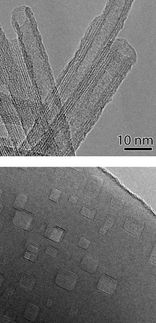Microbial fuel cell: High yield hydrogen source and wastewater cleaner
Using a new electrically-assisted microbial fuel cell (MFC) that does not require oxygen, Penn State environmental engineers and a scientist at Ion Power Inc. have developed the first process that enables bacteria to coax four times as much hydrogen directly out of biomass than can be generated typically by fermentation alone.
Dr. Bruce Logan, the Kappe professor of environmental engineering and an inventor of the MFC, says, "This MFC process is not limited to using only carbohydrate-based biomass for hydrogen production like conventional fermentation processes. We can theoretically use our MFC to obtain high yields of hydrogen from any biodegradable, dissolved, organic matter -- human, agricultural or industrial wastewater, for example -- and simultaneously clean the wastewater.
"While there is likely insufficient waste biomass to sustain a global hydrogen economy, this form of renewable energy production may help offset the substantial costs of wastewater treatment as well as provide a contribution to nations able to harness hydrogen as an energy source," Logan notes.
In a paper, the researchers explain that hydrogen production by bacterial fermentation is currently limited by the "fermentation barrier" -- the fact that bacteria, without a power boost, can only convert carbohydrates to a limited amount of hydrogen and a mixture of "dead end" fermentation end products such as acetic and butyric acids. However, giving the bacteria a small assist with a tiny amount of electricity -- about 0.25 volts or a small fraction of the voltage needed to run a typical 6 volt cell phone -- they can leap over the fermentation barrier and convert a "dead end" fermentation product, acetic acid, into carbon dioxide and hydrogen.
Logan notes, "Basically, we use the same microbial fuel cell we developed to clean wastewater and produce electricity. However, to produce hydrogen, we keep oxygen out of the MFC and add a small amount of power into the system."
In the new MFC, when the bacteria eat biomass, they transfer electrons to an anode. The bacteria also release protons, which go into solution. The electrons on the anode migrate via a wire to the cathode, the other electrode in the fuel cell, where they are electrochemically assisted to combine with the protons and produce hydrogen gas. A voltage in the range of 0.25 volts or more is applied to the circuit by connecting the positive pole of a programmable power supply to the anode and the negative pole to the cathode.
The researchers call their hydrogen-producing MFC a BioElectrochemically-Assisted Microbial Reactor or BEAMR. The BEAMR not only produces hydrogen but simultaneously cleans the wastewater used as its feedstock. It uses about one-tenth of the voltage needed for electrolysis, the process that uses electricity to break water down into hydrogen and oxygen.
Original Publication: H. Liu, S. Grot, L. Grot; "Electrochemically Assisted Microbial Production of Hydrogen from Acetate"; Environmental Science and Technology.
Most read news
Topics
Organizations
Other news from the department science

Get the chemical industry in your inbox
By submitting this form you agree that LUMITOS AG will send you the newsletter(s) selected above by email. Your data will not be passed on to third parties. Your data will be stored and processed in accordance with our data protection regulations. LUMITOS may contact you by email for the purpose of advertising or market and opinion surveys. You can revoke your consent at any time without giving reasons to LUMITOS AG, Ernst-Augustin-Str. 2, 12489 Berlin, Germany or by e-mail at revoke@lumitos.com with effect for the future. In addition, each email contains a link to unsubscribe from the corresponding newsletter.


























































